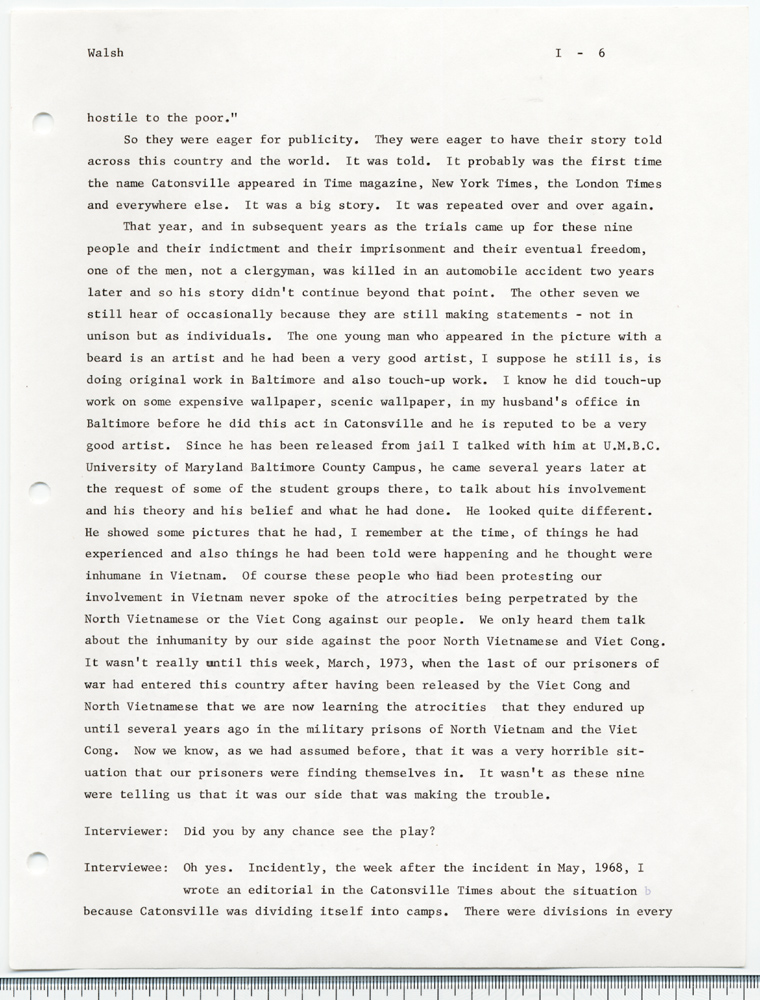 |
The Catonsville Nine's invasion and burning of the Catonsville draft board files: an interview with Jean S. Walsh given on March 30, 1973.
 |
10 / 15 |
 |



| Collection: |
Friends of Catonsville Library |
| Date: |
1973-03-30 |
| Date of Digitization: |
2004-03-31 |
| Source: |
Catonsville Library |
| Original Dimensions: |
28 x 22 cm |
| Creator: |
Walsh, Jean S. |
|
|
Description:
A transcript of a recorded interview with Jean S. Walsh, the editor of Catonsville's local newspaper, the Catonsville Times. She was present at the scene after the burning of draft records in Catonsville on May 17, 1968.
Transcription: hostile to the poor."
So they were eager for publicity. They were eager to have their story told
across this country and the world. It was told. It probably was the first time
the name Catonsville appeared in Time magazine, New York Times, the London Times
and everywhere else. It was a big story. It was repeated over and over again.
That year, and in subsequent years as the trials came up for these nine
people and their indictment and their imprisonment and their eventual freedom,
one of the men, not a clergyman, was killed in an automobile accident two years
later and so his story didn't continue beyond that point. The other seven we
still hear of occasionally because they are still making statements - not in
unison but as individuals. The one young man who appeared in the picture with a
beard is an artist and he had been a very good artist, I suppose he still is, is
doing original work in Baltimore and also touch-up work. I know he did touch-up
work on some expensive wallpaper, scenic wallpaper, in my husband's office in
Baltimore before he did this act in Catonsville and he is reputed to be a very
good artist. Since he has been released from jail I talked with him at U.M.B.C.
University of Maryland Baltimore County Campus, he came several years later at
the request of some of the student groups there, to talk about his involvement
and his theory and his belief and what he had done. He looked quite different.
He showed some pictures that he had, I remember at the time, of things he had
experienced and also things he had been told were happening and he thought were
inhumane in Vietnam. Of course these people who had been protesting our
involvement in Vietnam never spoke of the atrocities being perpetrated by the
North Vietnamese or the Viet Cong against our people. We only heard them talk
about the inhumanity by our side against the poor North Vietnamese and Viet Cong.
It wasn't really until this week, March, 1973, when the last of our prisoners of
war had entered this country after having been released by the Viet Cong and
North Vietnamese that we are now learning the atrocities that they endured up
until several years ago in the military prisons of North Vietnam and the Viet
Cong. Now we know, as we had assumed before, that it was a very horrible sit-
uation that our prisoners were finding themselves in. It wasn't as these nine
were telling us that it was our side that was making the trouble.
Interviewer: Did you by any chance see the play?
Interviewee: Oh yes. Incidently, the week after the incident in May, 1968, I
wrote an editorial in the Catonsville Times about the situation
because Catonsville was dividing itself into camps. There were divisions in every
|




